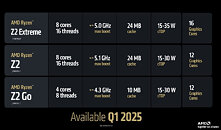
Sapphire at Computex 2025: Edge AI Mini PCs, NITRO+ PhantomLink Motherboard, RX 9060 XT
Sapphire brought unique new hardware to Computex 2025. We begin our tour with the new Sapphire Edge AI line of mini PCs. First up, is the Edge AI 370, a mini PC measuring 117 mm x 111 mm x 30 mm (WxDxH). It is powered by AMD Ryzen AI 9 HX 370 "Strix Point" mobile processor, with two DDR5 SO-DIMM slots supporting up to 96 GB of memory. Storage comes from a 1 TB Gen 4 NVMe SSD. The CPU is configured with 12 cores (4x Zen 5 + 8x Zen 5c), while the maxed out RDNA 3.5 iGPU has 16 CU. The XDNA 2 NPU is clocked for 50 AI TOPS, and meets Microsoft Copilot+ requirements.
Next up, is the Sapphire X870EA Wi-Fi PhantomLink Edition motherboard. This is Sapphire's first high-end motherboard in years. The Socket AM5 motherboard is based on the flagship AMD X870E chipset, and offers premium connectivity and I/O features. It's also designed to visually match the company's latest Radeon RX 9070 XT NITRO+ graphics card, but its most striking feature is PhantomLink. This is a backside power delivery feature similar to ASUS BTF. The main PCI-Express 5.0 x16 slot has a trailing power delivery slot that relays power from a 12V-2x6 power input located next to the 24-pin ATX connector on the motherboard. This may not be a complete backside I/O motherboard, but at least keeps the graphics card free from any power cables sticking out. To use PhantomLink, however, you need a compatible graphics card, and Sapphire showed us the Radeon RX 9070 XT NITRO+ PhantomLink Edition.
Next up, is the Sapphire X870EA Wi-Fi PhantomLink Edition motherboard. This is Sapphire's first high-end motherboard in years. The Socket AM5 motherboard is based on the flagship AMD X870E chipset, and offers premium connectivity and I/O features. It's also designed to visually match the company's latest Radeon RX 9070 XT NITRO+ graphics card, but its most striking feature is PhantomLink. This is a backside power delivery feature similar to ASUS BTF. The main PCI-Express 5.0 x16 slot has a trailing power delivery slot that relays power from a 12V-2x6 power input located next to the 24-pin ATX connector on the motherboard. This may not be a complete backside I/O motherboard, but at least keeps the graphics card free from any power cables sticking out. To use PhantomLink, however, you need a compatible graphics card, and Sapphire showed us the Radeon RX 9070 XT NITRO+ PhantomLink Edition.













































































